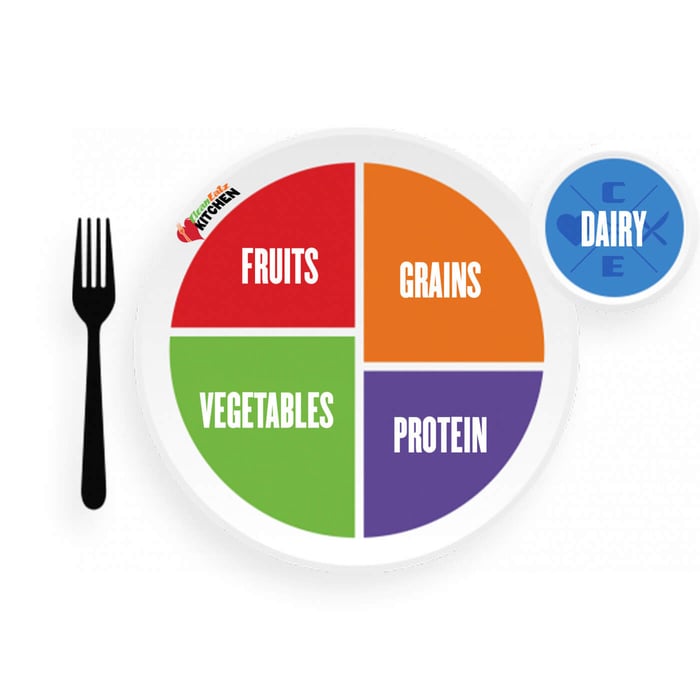Last updated: September 22, 2025
What to Eat to Lose Weight: Simple Rules, Portions & Sample Menus
Short answer: Fat loss happens when your weekly calories stay in a small deficit—made easier by high-protein meals, plenty of fiber-rich plants, and consistent habits you can live with. Use our calculators to set targets, then build every plate with a protein anchor + veg volume + smart carbs + measured fats. The tools and menus below make it automatic.
Start Here: Your Numbers in 3 Minutes
- Set calories: Use the Calorie Calculator. For most, a 300–500 kcal/day deficit is plenty.
- Set protein: Aim ~0.8–1.0 g per lb/day (or use our Protein Calculator). See why protein helps.
- Pick a structure: Most do great with 3 meals + 1 snack, each meal 25–40 g protein.
- Track simply: Use our Nutrition Label Converter for quick label math, or keep consistent CEK meals for predictable macros.
The Fueling Framework (4 Rules)
- Protein at every meal (25–40 g). You’ll feel fuller and keep muscle while losing fat.
- Fill half your plate with non-starchy veggies for volume, fiber, and micronutrients.
- Smart carbs (fruit, oats, rice, potatoes, beans) sized to your calories; emphasize around training.
- Measure fats (oils, nuts, cheese, sauces). Great for flavor—easy to overpour. Start with 1–2 tsp oil per plate.
Hydration matters: water first; on hot/training days add light electrolytes—see Electrolytes guide.
Plate Builder & Portion Guide
| Component | Easy options | Starter portions | Notes |
|---|---|---|---|
| Protein anchor | Chicken/turkey, fish/shrimp, lean beef, eggs + egg whites, Greek yogurt/skyr, tofu/tempeh | ~4–6 oz cooked meat/fish • 1 cup yogurt • ¾–1 block tofu | Target 25–40 g per meal |
| Veg volume | Leafy greens, broccoli/cauli, zucchini, peppers, mushrooms, tomatoes | ½ plate minimum (2–3 cups raw or 1–2 cups cooked) | Roast, grill, or sauté with measured oil |
| Smart carbs | Rice, potatoes, oats, quinoa, beans/lentils, fruit | ½–1 cup cooked (or 1 medium fruit) | Flex up/down by activity and calories |
| Measured fats | Olive oil, avocado, nuts/seeds, cheese | 1–2 tsp oil • ¼ avocado • 1 oz nuts • 1–2 oz cheese | Flavor yes; pour with purpose |
Sample Menus (1500, 1800, 2200 kcal)
Swap portions to fit your calories with the Meal Plan Generator. Each day hits ~100–160 g protein depending on calories.
~1500 kcal
- Breakfast: Greek yogurt (¾–1 cup) + berries + ½ scoop protein powder
- Lunch: CEK entrée from the High-Protein Box + side salad
- Snack: Cottage cheese (¾ cup) + pineapple
- Dinner: Salmon (4–5 oz) + roasted veg + small potato
~1800 kcal
- Breakfast: Eggs (2) + egg whites (3–4) + fruit
- Lunch: Chicken burrito bowl (rice/beans/veg)
- Snack: Protein shake + apple
- Dinner: CEK entrée + extra frozen veg
~2200 kcal
- Breakfast: Protein oatmeal (oats + scoop whey + berries)
- Lunch: Tuna & white-bean salad + whole-grain pita — see tuna guide
- Snack: Skyr/Greek yogurt + measured granola
- Dinner: Lean steak or tofu stir-fry + rice + veggies
Grocery List (Budget-Friendly)
- Proteins: eggs, canned tuna/salmon, chicken thighs/breasts, turkey, lean beef, tofu/tempeh, Greek yogurt/skyr, cottage cheese
- Veg & fruit: frozen veg blends, leafy greens, broccoli/cauli, peppers, onions, apples/berries
- Pantry carbs: rice, potatoes, oats, beans/lentils, whole-grain wraps
- Fats & flavor: extra-virgin olive oil, avocado, nuts/seeds, spices, mustard, hot sauce (hot sauce guide)
Eating Out & Travel Playbooks
Restaurant Orders (macro-friendly)
- Protein + veg + 1 carb: Grilled chicken/fish + double veg + small rice/potato; sauces on the side
- Bowls: ½ rice + extra veg + lean protein + salsa; skip creamy dressings or ask for light
- Burgers: Bun-less or single bun; add side salad/veg
Travel Day
- Pack protein (jerky, RTD shake, yogurt if you can keep cold), fruit, nuts (1 oz)
- Hydrate; use a light electrolyte on long flights (see guide)
- Hotel microwave/fridge? Stock CEK entrées from Build-a-Meal Plan
Fueling Workouts (Pre/Post & Electrolytes)
- Pre (1–3 h): Protein + carbs (e.g., yogurt + fruit, toast + eggs)
- Post (within a few hours): Protein 25–40 g + a smart carb if the session was hard
- Cardio plans: Try our treadmill workouts or elliptical guide
Save Money & Time (Batch Prep & CEK Shortcuts)
- Batch once/week: roast proteins/veg, cook a pot of rice/potatoes, pre-chop salad veg
- Template dinners: “Protein + sheet-pan veg + starch” rotated with different spices
- CEK safety net: Keep a few High-Protein Box entrées for hectic days
Common Pitfalls & Easy Fixes
| Pitfall | Why it stalls progress | Fix |
|---|---|---|
| Low protein | Hunger, muscle loss | Hit your daily target; see protein guide |
| “Healthy” but calorie-dense sauces/oils | Portion creep | Measure fats; 1–2 tsp oil per meal |
| Liquid calories | Easy to overshoot | Water, coffee/tea, seltzer; see kombucha tips |
| All cardio, no strength | Plateaus, shape doesn’t change | Lift 2–4×/week; add short planks—see plank guide |
| Weekend wipeouts | Erase weekday deficit | Use calorie cycling to plan higher-cal days |
Related CEK Tools, Guides & Meals
- Calculators: Calories • Protein • Weight-Loss %
- Guides: Protein for Fat Loss • Healthy Snacks • Smart Swaps • When You’ll Notice Results
- Workouts: Treadmill • Elliptical • Planks
- Meals: High-Protein Box • Build-a-Meal Plan • Weight-Loss Meal Plan • Protein Powder
FAQs
How big should my calorie deficit be?
Small wins beat crash diets. A 300–500 kcal/day average deficit is sustainable for most. Start with the Calorie Calculator.
How much protein per day?
Roughly 0.8–1.0 g per lb/day, split across meals (25–40 g each). Get your number with the Protein Calculator.
Do I need to cut carbs?
No. Carbs can fit your calories—especially around training. Choose fiber-rich options and size portions to your plan. See Carb basics.
What about intermittent fasting?
It can help adherence if it suits your lifestyle. Results still come from weekly calories and adequate protein.
How fast will I see results?
Energy and appetite control often improve in 1–2 weeks. Visible changes vary—see how long it takes.
Disclaimer: This article provides general nutrition guidance and isn’t medical advice. If you have medical conditions or take medications, consult your clinician.




